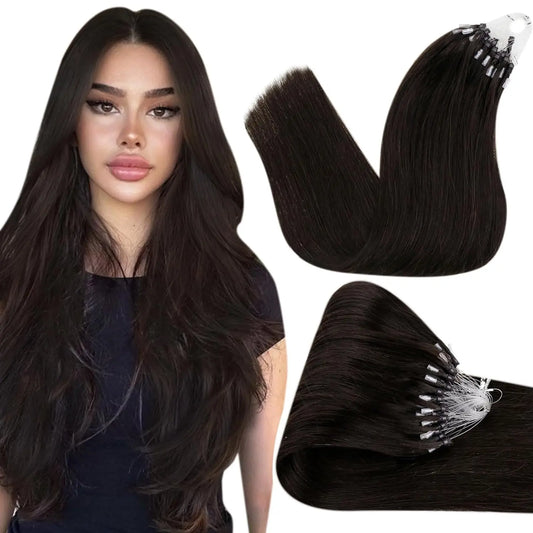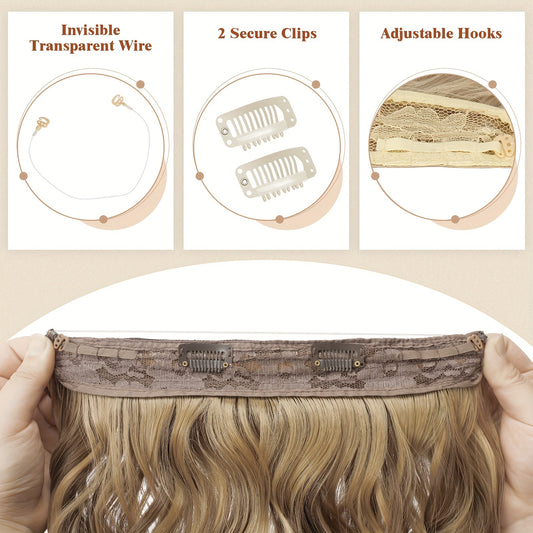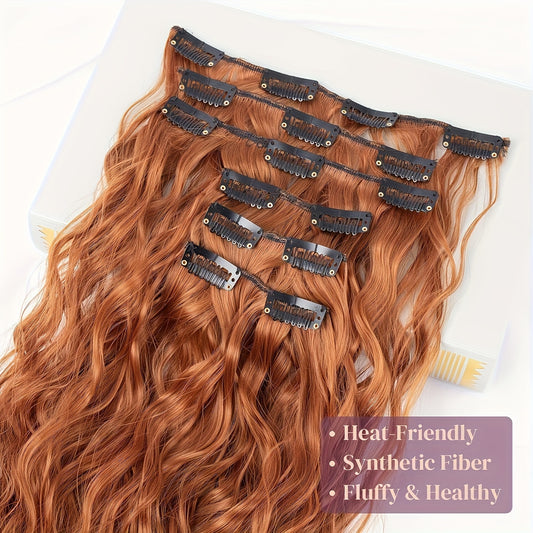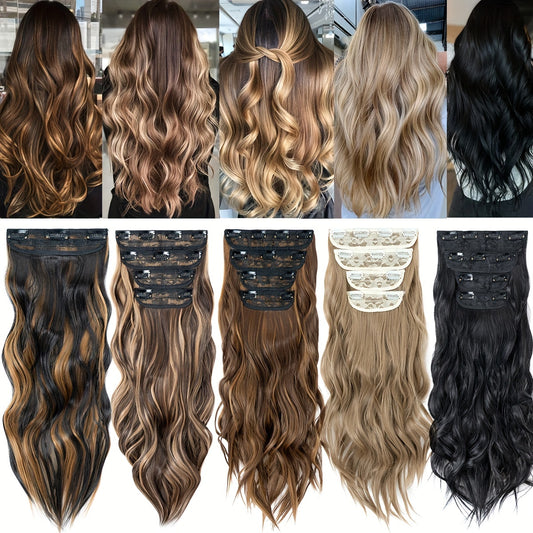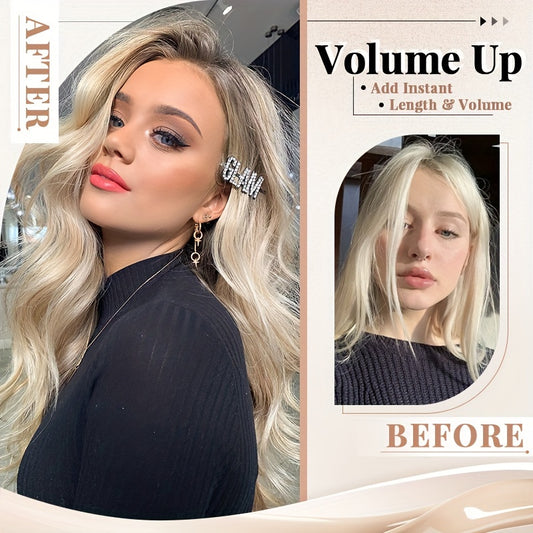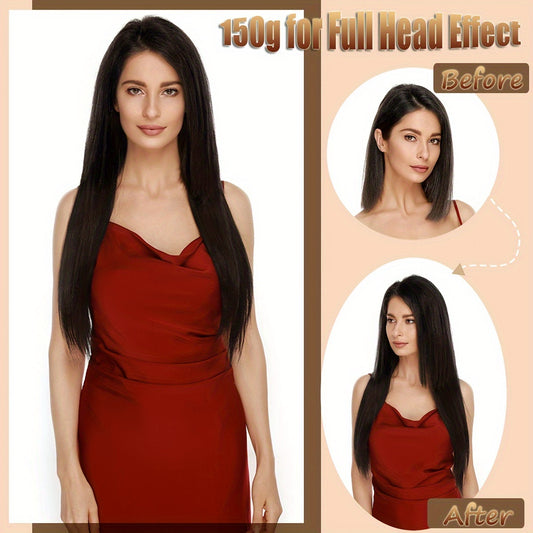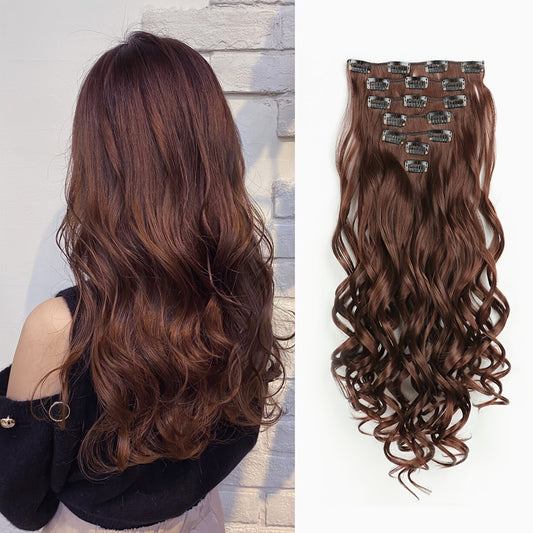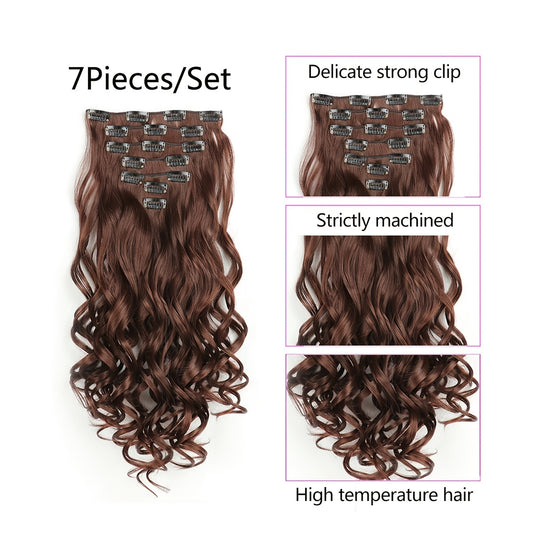About Full Head Clip In Hair Extensions
A full head set consists of multiple wefts sized for different zones. You use wide pieces across the back, medium arcs across the occipital curve, and narrow side panels at the temples. The format allows precise control of weight distribution and coverage. When you match grams to your haircut, choose a draw for the edge you want, and keep the crown layer generous, the set reads like your hair on its best day—longer, fuller, and steady under motion and light.
System overview
Clips are small pressure springs with silicone sleeves that anchor without sharp edges. Each weft base carries hair and spreads load across anchors. Installation is modular: place rows low, anchor the center clip first, close side clips to share tension, and protect the canopy—the unwefted top layer that hides hardware. Removal reverses the sequence and takes seconds. Because the system is removable, you adjust piece count day to day: a minimal map for errands, a full build for content or events, and a mid build for office and classroom days.
The advantage of a full head set over single piece formats is control. You can correct temple hollows, distribute grams where a blunt line needs strength, and lighten the crown zone to keep movement and concealment. Precision comes from the number of pieces you choose and where you place them.
Set components
A well built full head kit includes one or two wide wefts for the lower back, one or two medium arcs for the occipital, and two to four narrow side panels for temples. Some sets include a very slim cover strip for high placement insurance in wind. Clip count per weft varies: wide pieces carry three to five clips, mediums carry two or three, and narrow panels carry one or two. The variety lets you map for your head shape rather than forcing pieces where they do not belong.
Construction types include machine sewn wefts, seamless or injection wefts with a thin base, and hybrid wefts that split the difference. Machine sewn rows carry more hair per inch and resist friction well in the lower back; seamless rows lay flatter near the crown. A mixed set often offers the most versatility: strong lower rows and discreet upper rows.
Materials and consistency
Remy human hair with aligned cuticles remains the standard for predictable styling. Aligned cuticles reduce friction and reflect light softly. Processing should be gentle; fiber that is over processed tends to mat and loses sheen quickly. Clips should have consistent spring tension and uniform silicone sleeves. Durable stitching along the seam keeps weight distribution even and avoids early fray. Honest heat caps printed in degrees signal material discipline, which matters more than adjectives when you plan for longevity.
Quality shows in proof, not in slogans. The most useful photo on any long hair page is a cropped daylight back view of ends at rest. Numbers such as grams per set and heat limits in degrees are the language of results.
Fabulive publishes grams per set, daylight end crops, and heat caps in degrees so buyers can plan coverage instead of guessing.
Weight planning
Weight, measured in grams, controls end authority. Too little weight produces a long but unfinished hem; too much weight in the wrong zone looks bulky and risks exposure. Use this ladder to start. Around one hundred to one hundred twenty grams: subtle perimeter repair for layered hair worn in soft waves and low product routines. One hundred thirty to one hundred sixty grams: everyday density that photographs clean without heavy feel; ideal for many heads. One hundred seventy to two hundred thirty grams: a plush, deliberate hem for blunt cuts, thicker strands, studio lighting, or humid climates. Above two hundred thirty grams: specialty builds for very dense natural hair or razor straight finishes under hard light.
Distribution matters as much as total grams. The lowest row sets stability. The occipital arc builds body. Narrow side panels erase temple hollows that cameras notice first in three quarter angles. If the face frame reads thin while the back looks dense, add or trim side panels rather than stacking heavier back rows. Proportion is realism.
Length by landmarks
Length must be selected by where the hem lands on your body. On many frames, 14 inches sits near the collarbone, 16 at upper chest, 18 mid chest, 20 lower chest, 22 near ribs, 24 toward the waist, and 26 into the waist or upper hip. Waves read one to two inches shorter; curls read even shorter. Measure from behind the ear to your target landing point to simulate the hang of a weft. Test the measure while wearing common necklines and outerwear; long hair should frame garments, not fight collars and straps.
If you want a crisp straight edge, plan slightly higher grams than for wave finishes. Straight photos do not forgive a soft perimeter. A micro trim of half an inch to one inch after the first two wears tightens the line without sacrificing the idea of length.
End draw and hem geometry
Fabulive’s quick maps emphasize a generous canopy and low placement, which aligns with the concealment logic described here.
Draw describes how density carries into the bottom third. Single drawn tapers gently and reads organic; it moves easily and excels in wave finishes. Double drawn holds density deeper into the perimeter and reads like a fresh cut in straight or beveled looks. Choose by finish goal and camera needs. Many buyers prefer a hybrid: firm draw in the lowest row and softer draw up top. The hem is what viewers see first; getting draw right is the fast track to a premium result.
Bevel is the small inward curve at the ends that makes a straight outline read calm and deliberate. One slow pass and a brief cool followed by a single brush creates that salon fresh impression without heavy product.
Texture and effort
When comparing textures and shades, Fabulive labels undertone clearly and shows the same color in daylight from multiple angles.
Straight textures display length most clearly and show static fastest; they reward low heat and clean handling. Body wave is the universal blender: one slow pass brushes it straight; one set plus complete cooling yields soft bends that hide joins. Loose curl and deep wave provide defined pattern; blending is easiest when coil diameter aligns with your own hair. Coily textures deserve clear diameter and shrinkage labeling plus both defined and brushed out photos for honest expectations.
Choose texture by routine and climate. If most days are blowouts, straight fits. If you alternate smooth with bend, body wave saves time. If you live in curls, match coil scale and define with water first, then product. The right choice reduces pass count and preserves fiber life.
Color selection and daylight checks
Match undertone first—cool, neutral, warm—then match depth. Verify by a window in daylight. Indoor bulbs skew warm or cool and can mislead. If you sit between shades, slightly lighter is safer because human hair accepts cooling or deepening with demi toners; lifting lighter raises cuticles and shortens life. Rooted and balayage options blur seams at parts and temples. Mixing a slightly deeper lowlight row under a lighter row builds dimension that looks like sun rather than dye.
Record your choice with a quick daylight photo next to your mid lengths and keep the shade code, grams, and texture. Reorders stay consistent across seasons and devices when you carry proof instead of memory.
Placement maps
Classic center part: place the widest weft above the nape, a second wide weft where the head begins to curve, one or two medium arcs along the occipital, and paired side panels trimmed on a slight diagonal just behind the hairline. Deep side part: mirror the classic map but add one extra narrow piece on the heavy side to maintain balance when swept. Fine crowns: keep rows lower, reduce piece count near the crown, and protect the canopy; your top layer is a concealment budget that should not be overspent.
For predictable ownership, Fabulive posts wash cadence and the no sleep guidance in plain language rather than slogans.
Anchoring method: tease lightly or dust a small root texture powder where clips will sit; avoid oils at anchors. Close the center clip first, then the sides to spread load. Support each row with your free hand while brushing to avoid twisting seams. These tiny habits prevent pressure and keep hardware invisible.
Face frame and temple balance
Three quarter photos reveal temple hollows before they reveal the back. Two slim side panels, trimmed to echo your face framing layers, remove the hollows without adding bulk near the crown. If your cut includes short face framing, choose one narrow piece a shade deeper or slightly cooler near the face; micro shadow sharpens jawline contours on camera. When trimming side panels, match the angle of your cut to avoid a shelf at the cheek.
If you mix rooted and balayage options, Fabulive’s swatch grid helps verify undertone quickly by a window before ordering.
For side parts, add a touch more density on the heavy side. For center parts, mirror the sides. The goal is equal perceived density, not perfect symmetry by weight.
Heat and finishing rules
Cap tools at or under one hundred eighty Celsius or three hundred fifty Fahrenheit. One slow pass is cleaner than several fast ones. For waves, alternate directions in the back and go away from the face at the front. Allow complete cooling before brushing into a single pattern; cooling locks the shape you created. Spray flexible hold onto the brush rather than directly onto hair; sheen stays natural and stiff spots do not form. Finish with a pea of serum on mid lengths and ends only.
For straight days, bevel the last half inch to one inch so the edge reads like a fresh cut. For coily days, define with water first and product second, and fluff only when fully dry. Avoid heavy oils at roots; grip depends on clean texture.
Comfort and ergonomics
Distribute weight across more anchors rather than stacking near the crown. Rotate exact clip positions a few millimeters between wears to protect the same follicles from constant load. Support rows with your free hand while brushing so torque does not twist seams. Sweep hair forward before zipping jackets. Choose smooth strap bags and avoid hook and loop closures near the perimeter. Brush once after removing outerwear or long seating to reset the hem.
Comfort is non negotiable. If pressure appears, reduce piece count for daily routines and add panels back for events. A full head set gives you that choice without sacrificing results.
Daily rhythm
Morning: brush your hair and the wefts, install using the chosen map, set shape with low to moderate heat if needed, allow full cooling, and brush once into the final pattern. Midday: after outerwear or long chair sessions, brush the hem once. Evening: brush, remove rows, coil wefts in a gentle U, and store in a satin pouch away from heat. Weekly: wash extensions every ten to fifteen wears or when product buildup appears. Air dry as far as possible before minimal finishing.
Do not sleep in clip ins. Keep anchor zones clear of heavy oils. Label side panels inside the pouch so temple placement repeats. Record shade code, grams, and tool settings so the best day becomes your routine rather than a surprise.
Care and washing
Submerge wefts in cool or lukewarm water. Emulsify a small amount of gentle shampoo in your hands and squeeze through lengths; do not scrub seams. Rinse thoroughly. Condition mid lengths to ends, detangle while saturated using a wide tooth comb or fingers, and rinse cool to close cuticles. Blot with microfiber—no wringing. Air dry flat or on hangers. Clarify occasionally if product stacking dulls fiber. Replace tired clips rather than retiring entire rows; hardware is a service part.
Schedule a seasonal micro trim of half an inch to reset edge authority. Trim after at least two wears so fiber relaxes and the true hem reveals itself. With measured heat and satin storage, full head systems stay camera ready for months.
Troubleshooting quick list
Seam flashes in wind: canopy too thin or part sits over a row; lower the map one step, shift the part a few millimeters, or add a slim cover strip higher on the side. Perimeter looks foggy in straight photos: request a half inch trim or choose a firmer draw next order. Crown reads puffy: rows placed too high under a thin canopy; remap lower and reduce piece count at the top. Clips slip on fine hair: avoid heavy conditioners at anchor zones, dust a light texture powder, and clean clip teeth.
Color looks correct outdoors but warm indoors: trust daylight; glaze cooler briefly if needed. Nape tangles under scarves and backpacks: hydrate ends and brush after removing layers; consider a slightly shorter length for heavy outerwear season. Small, calm adjustments solve most issues.
Event workflow
Define or smooth earlier than you think and allow complete cooling or drying while you finish makeup and dressing. Install after both your hair and the wefts are dry; mixing wet and dry creates frizz. For outdoor events, plan a part shift and a temporary ear tuck between buildings. Pack a small kit: a loop brush, a travel sprayer with water, a flexible hold, and tissue to smooth palms when breaking a gel cast. A five minute reset carries the look from first photo to last.
For weddings or long shoots, schedule one mid event refresh: mist hands, press definition back into place, and polish ends with a tiny drop of serum. Resist stacking products directly; water memory revives shape with less buildup.
Page signals that reduce returns
A helpful full head collection page shows the same shade in daylight from front, side, and back, plus a tight crop of ends at rest. It lists grams per set and heat caps in degrees. It identifies which pieces are wide, medium, and narrow and how many clips each carries. Filters include grams, texture, and shade families with undertone labels. Each tile can add a small cue like everyday density or glam hem to guide selection without clutter.
An FAQ answers length by landmarks, washing cadence, return basics for unopened hair, and the no sleep guideline. A color assist note reminds buyers to check undertone at a window. Clarity increases accurate orders and reduces support loops.
Accessibility and inclusion
Pair shade names with numeric descriptors such as level 6 neutral brown so color blind buyers can map choices. Provide alt text that includes method, length, texture, undertone, and draw. Ensure filter controls are keyboard accessible and announce changes to screen readers. Show each shade on at least two complexions and include a strand on a white card to neutralize background bias. Provide inches and centimeters and keep grams consistent across options.
Inclusive presentation improves outcomes. When people recognize their texture and routine in images and data, selection becomes confident and returns decline.
Sustainability and ownership
Removable full head systems last months when handled with low heat, modest products, and gentle washing. Because the hair rests between wears, fiber fatigue accumulates slowly. Cost per wear compares favorably to frequent salon services once you own the routine. Spare clips, recyclable pouches, and clear repair guidance promote reuse over replacement. Education—especially on grams, texture, and length landmarks—prevents mismatches that become returns.
Predictability is the sustainability engine. When your map, grams, and settings repeat, you avoid constant experiments and waste fewer products. Calm routines tend to be the greener ones.
Glossary
Weft: a horizontal strip of hair attached to a seam; clips anchor the weft to your hair. Grams: total weight of hair in a set; controls end authority. Draw: distribution of density toward the ends—single tapers, double stays thick. Canopy: the top layer of unwefted hair that hides hardware. Occipital: the back curve of the head where structural rows sit. Temple panel: a narrow side piece that fills hollows near the face.
Bevel: a small inward curve at the very ends that reads like a fresh cut in straight styles. Cover strip: a slim upper piece used as wind insurance. Cooling rule: let hot hair cool before brushing so shape sets. Root texture powder: a light product that adds grip at anchor zones without oil.
Summary
Full head clip in hair extensions offer modular control over coverage and weight. Plan grams for the haircut you have, choose length by body landmarks, match color by undertone in daylight, keep rows low under a generous canopy, and finish with capped heat and complete cooling. Treat side panels as face framing tools, not afterthoughts, and record shade code, grams, and tool settings so results repeat quickly. When the map respects concealment and comfort, the hair reads premium in photos and in motion.
If any step becomes confusing, return to the sequence: section low, anchor center then sides, distribute weight across the occipital, keep the crown generous, cap heat, cool fully, and brush once. Small, repeatable moves beat product stacks and trend chasing every time.
Mechanical view of mapping
A multi row map behaves like a lattice: stiffness rises across the occipital arc where curvature disperses tension and keeps seams level when you brush. Supporting each row with your free hand during brushing limits torque on clips and preserves alignment over time. Load sharing matters; if a single anchor carries force repeatedly, tenderness appears first at that point. Planning for structure rather than slogans makes comfort predictable.
Mechanical view of mapping
A multi row map behaves like a lattice: stiffness rises across the occipital arc where curvature disperses tension and keeps seams level when you brush. Supporting each row with your free hand during brushing limits torque on clips and preserves alignment over time. Load sharing matters; if a single anchor carries force repeatedly, tenderness appears first at that point. Planning for structure rather than slogans makes comfort predictable.
Mechanical view of mapping
A multi row map behaves like a lattice: stiffness rises across the occipital arc where curvature disperses tension and keeps seams level when you brush. Supporting each row with your free hand during brushing limits torque on clips and preserves alignment over time. Load sharing matters; if a single anchor carries force repeatedly, tenderness appears first at that point. Planning for structure rather than slogans makes comfort predictable.
Mechanical view of mapping
A multi row map behaves like a lattice: stiffness rises across the occipital arc where curvature disperses tension and keeps seams level when you brush. Supporting each row with your free hand during brushing limits torque on clips and preserves alignment over time. Load sharing matters; if a single anchor carries force repeatedly, tenderness appears first at that point. Planning for structure rather than slogans makes comfort predictable.
Mechanical view of mapping
A multi row map behaves like a lattice: stiffness rises across the occipital arc where curvature disperses tension and keeps seams level when you brush. Supporting each row with your free hand during brushing limits torque on clips and preserves alignment over time. Load sharing matters; if a single anchor carries force repeatedly, tenderness appears first at that point. Planning for structure rather than slogans makes comfort predictable.
Mechanical view of mapping
A multi row map behaves like a lattice: stiffness rises across the occipital arc where curvature disperses tension and keeps seams level when you brush. Supporting each row with your free hand during brushing limits torque on clips and preserves alignment over time. Load sharing matters; if a single anchor carries force repeatedly, tenderness appears first at that point. Planning for structure rather than slogans makes comfort predictable.
Mechanical view of mapping
A multi row map behaves like a lattice: stiffness rises across the occipital arc where curvature disperses tension and keeps seams level when you brush. Supporting each row with your free hand during brushing limits torque on clips and preserves alignment over time. Load sharing matters; if a single anchor carries force repeatedly, tenderness appears first at that point. Planning for structure rather than slogans makes comfort predictable.
Mechanical view of mapping
A multi row map behaves like a lattice: stiffness rises across the occipital arc where curvature disperses tension and keeps seams level when you brush. Supporting each row with your free hand during brushing limits torque on clips and preserves alignment over time. Load sharing matters; if a single anchor carries force repeatedly, tenderness appears first at that point. Planning for structure rather than slogans makes comfort predictable.
Mechanical view of mapping
A multi row map behaves like a lattice: stiffness rises across the occipital arc where curvature disperses tension and keeps seams level when you brush. Supporting each row with your free hand during brushing limits torque on clips and preserves alignment over time. Load sharing matters; if a single anchor carries force repeatedly, tenderness appears first at that point. Planning for structure rather than slogans makes comfort predictable.
Mechanical view of mapping
A multi row map behaves like a lattice: stiffness rises across the occipital arc where curvature disperses tension and keeps seams level when you brush. Supporting each row with your free hand during brushing limits torque on clips and preserves alignment over time. Load sharing matters; if a single anchor carries force repeatedly, tenderness appears first at that point. Planning for structure rather than slogans makes comfort predictable.
Mechanical view of mapping
A multi row map behaves like a lattice: stiffness rises across the occipital arc where curvature disperses tension and keeps seams level when you brush. Supporting each row with your free hand during brushing limits torque on clips and preserves alignment over time. Load sharing matters; if a single anchor carries force repeatedly, tenderness appears first at that point. Planning for structure rather than slogans makes comfort predictable.
Mechanical view of mapping
A multi row map behaves like a lattice: stiffness rises across the occipital arc where curvature disperses tension and keeps seams level when you brush. Supporting each row with your free hand during brushing limits torque on clips and preserves alignment over time. Load sharing matters; if a single anchor carries force repeatedly, tenderness appears first at that point. Planning for structure rather than slogans makes comfort predictable.
Mechanical view of mapping
A multi row map behaves like a lattice: stiffness rises across the occipital arc where curvature disperses tension and keeps seams level when you brush. Supporting each row with your free hand during brushing limits torque on clips and preserves alignment over time. Load sharing matters; if a single anchor carries force repeatedly, tenderness appears first at that point. Planning for structure rather than slogans makes comfort predictable.
Mechanical view of mapping
A multi row map behaves like a lattice: stiffness rises across the occipital arc where curvature disperses tension and keeps seams level when you brush. Supporting each row with your free hand during brushing limits torque on clips and preserves alignment over time. Load sharing matters; if a single anchor carries force repeatedly, tenderness appears first at that point. Planning for structure rather than slogans makes comfort predictable.
Mechanical view of mapping
A multi row map behaves like a lattice: stiffness rises across the occipital arc where curvature disperses tension and keeps seams level when you brush. Supporting each row with your free hand during brushing limits torque on clips and preserves alignment over time. Load sharing matters; if a single anchor carries force repeatedly, tenderness appears first at that point. Planning for structure rather than slogans makes comfort predictable.
Mechanical view of mapping
A multi row map behaves like a lattice: stiffness rises across the occipital arc where curvature disperses tension and keeps seams level when you brush. Supporting each row with your free hand during brushing limits torque on clips and preserves alignment over time. Load sharing matters; if a single anchor carries force repeatedly, tenderness appears first at that point. Planning for structure rather than slogans makes comfort predictable.
Mechanical view of mapping
A multi row map behaves like a lattice: stiffness rises across the occipital arc where curvature disperses tension and keeps seams level when you brush. Supporting each row with your free hand during brushing limits torque on clips and preserves alignment over time. Load sharing matters; if a single anchor carries force repeatedly, tenderness appears first at that point. Planning for structure rather than slogans makes comfort predictable.
Mechanical view of mapping
A multi row map behaves like a lattice: stiffness rises across the occipital arc where curvature disperses tension and keeps seams level when you brush. Supporting each row with your free hand during brushing limits torque on clips and preserves alignment over time. Load sharing matters; if a single anchor carries force repeatedly, tenderness appears first at that point. Planning for structure rather than slogans makes comfort predictable.
Mechanical view of mapping
A multi row map behaves like a lattice: stiffness rises across the occipital arc where curvature disperses tension and keeps seams level when you brush. Supporting each row with your free hand during brushing limits torque on clips and preserves alignment over time. Load sharing matters; if a single anchor carries force repeatedly, tenderness appears first at that point. Planning for structure rather than slogans makes comfort predictable.
Mechanical view of mapping
A multi row map behaves like a lattice: stiffness rises across the occipital arc where curvature disperses tension and keeps seams level when you brush. Supporting each row with your free hand during brushing limits torque on clips and preserves alignment over time. Load sharing matters; if a single anchor carries force repeatedly, tenderness appears first at that point. Planning for structure rather than slogans makes comfort predictable.
Mechanical view of mapping
A multi row map behaves like a lattice: stiffness rises across the occipital arc where curvature disperses tension and keeps seams level when you brush. Supporting each row with your free hand during brushing limits torque on clips and preserves alignment over time. Load sharing matters; if a single anchor carries force repeatedly, tenderness appears first at that point. Planning for structure rather than slogans makes comfort predictable.
Customer reviews
- Installed the full set in ten minutes and the hem finally reads like a fresh cut on camera; a consistent edge without salon time. — Riley Morgan, USA ⭐⭐⭐⭐⭐
- Numbers for grams and heat caps matched reality, and concealment stayed perfect once I kept rows lower on the back curve. — Daniel Carter, Canada ⭐⭐⭐⭐⭐
- Sensitive scalp here, but distributing weight across more anchors made a long day comfortable; temple panels fixed my front view. — Amelia Hughes, United Kingdom ⭐⭐⭐⭐
- Body wave blends with my blowout routine and the brushed pattern holds after cooling; simple and reliable. — Chloe Bennett, Australia ⭐⭐⭐⭐⭐
- Two narrow side pieces on a diagonal erased the hollow near my cheeks; my three quarter photos look balanced now. — Sofia Martin, Italy ⭐⭐⭐⭐⭐
- Shipping ran a day long for me, so four stars, but the clips have real spring and the hair takes a bevel beautifully. — Harper Wright, USA ⭐⭐⭐⭐
- On video calls the silhouette reads calm—no flashing under LEDs—and the crown layer keeps hardware hidden. — Grace Allen, USA ⭐⭐⭐⭐⭐
- Wind along the river and a tiny part shift plus a slim cover strip kept everything invisible outdoors. — Hannah Collins, United Kingdom ⭐⭐⭐⭐⭐
- First full head kit and the section–anchor–blend rhythm clicked immediately; I logged shade code, grams, and temps for reorders. — Olivia Tremblay, Canada ⭐⭐⭐⭐⭐
- I remove rows for workouts and reinstall for dinner; one brush resets the hem with minimal tangling. — Charlotte King, Australia ⭐⭐⭐⭐⭐


